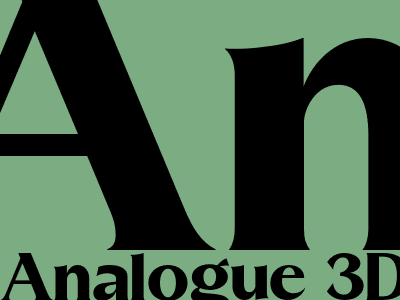
Unlocking the Immersive World of Analogue 3D
Rediscovering the Tangible Magic of 3D Creation
In an era dominated by digital advancements, the resurgence of analogue 3D printing offers a tactile and engaging alternative to virtual realms. Analogue 3D encompasses various techniques, including stereolithography, selective laser sintering, and fused deposition modeling, that utilize physical materials to create three-dimensional objects.
The allure of analogue 3D lies in its tangible nature. Unlike digital renderings, physical models allow for hands-on interaction, enabling designers and creators to experience their creations in a tangible and immediate way. This tactile experience fosters a deeper understanding of form, texture, and function, empowering creators to refine their designs with greater precision.
Exploring the Advantages of Analogue 3D Printing
Rapid Prototyping and Physical Verification
Analogue 3D printing excels in rapid prototyping, allowing designers to quickly create physical models from digital files. This process accelerates the design cycle, enabling engineers and inventors to evaluate concepts and make informed decisions before committing to production.
Physical prototypes also provide a tangible means of testing and verifying designs, eliminating potential issues that may arise during manufacturing. By interacting with physical models, designers can identify flaws and make necessary adjustments, ensuring optimal performance and functionality.
Material Diversity and Customization
Analogue 3D printing offers a wide range of materials, from plastics and metals to ceramics and composites, providing designers with greater flexibility and customization options. This enables the creation of prototypes and end-use products with varying properties, such as strength, durability, and aesthetics.
The ability to customize materials empowers designers to tailor their creations to specific applications. For instance, biomedical engineers can utilize biocompatible materials to develop patient-specific implants, while aerospace engineers can employ lightweight and durable alloys for aircraft components.
Educational and Creative Applications
Analogue 3D printing has gained traction in educational settings, providing students with hands-on experience in design and manufacturing. By creating physical models, students can visualize complex concepts, develop problem-solving skills, and foster their creativity.
In artistic endeavors, analogue 3D printing opens up new possibilities for sculpture, jewelry, and other forms of creative expression. Artists can leverage the technology to produce intricate and unique pieces that transcend the limitations of traditional mediums.
Integration with Digital Workflows
Analogue 3D printing seamlessly integrates with digital workflows, enabling designers to transition effortlessly between virtual and physical realms. Computer-aided design (CAD) software allows designers to create digital models, which can be directly exported to 3D printers, streamlining the design and production process.
This integration empowers designers to make rapid modifications in digital environments and instantly visualize the changes in physical form through 3D printing. The seamless interplay between digital and physical allows for iterative design and rapid prototyping, accelerating innovation and product development.
Embracing Analogue 3D for the Future
As technology continues to advance, analogue 3D printing remains a valuable tool for designers, engineers, artists, and educators. Its tangible nature, material diversity, and seamless integration with digital workflows make it an indispensable asset in the exploration of new ideas and the creation of innovative products.
By embracing analogue 3D, we unlock a world of immersive 3D creation, empowering us to push the boundaries of design, innovation, and creativity.